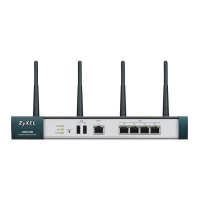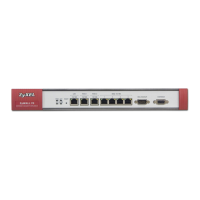Chapter 11 Network Address Translation (NAT)
XMG3512-B10A User’s Guide
159
11.6 The ALG Screen
Some NAT routers may include a SIP Application Layer Gateway (ALG). A SIP ALG allows SIP calls to pass
through NAT by examining and translating IP addresses embedded in the data stream. When the XMG
registers with the SIP register server, the SIP ALG translates the XMG’s private IP address inside the SIP
data stream to a public IP address. You do not need to use STUN or an outbound proxy if your XMG is
behind a SIP ALG.
Use this screen to enable and disable the ALGs in the XMG. To access this screen, click Network Setting >
NAT > ALG.
Figure 85 Network Setting > NAT > ALG
The following table describes the fields in this screen.
11.7 The Address Mapping Screen
Ordering your rules is important because the XMG applies the rules in the order that you specify. When a
rule matches the current packet, the XMG takes the corresponding action and the remaining rules are
ignored.
Click Network Setting > NAT > Address Mapping to display the following screen.
Figure 86 Network Setting > NAT > Address Mapping
Table 62 Network Setting > NAT > ALG
LABEL DESCRIPTION
NAT ALG Enable this to make sure applications such as FTP and file transfer in IM applications work
correctly with port-forwarding and address-mapping rules.
SIP ALG
Enable this to make sure SIP (VoIP) works correctly with port-forwarding and address-mapping
rules.
RTSP ALG
Enable this to have the XMG detect RTSP traffic and help build RTSP sessions through its NAT. The
Real Time Streaming (media control) Protocol (RTSP) is a remote control for multimedia on the
Internet.
PPTP ALG
Enable this to turn on the PPTP ALG on the XMG to detect PPTP traffic and help build PPTP
sessions through the XMG’s NAT.
IPSEC ALG
Enable this to turn on the IPsec ALG on the XMG to detect IPsec traffic and help build IPsec
sessions through the XMG’s NAT.
Apply Click Apply to save your changes.
Cancel Click Cancel to restore your previously saved settings.

